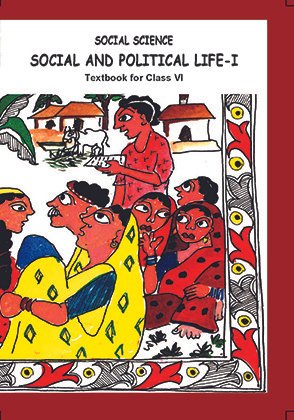
Political Science
NCERT – Class 6th

CH1. Understanding Diversity
- Diversity in India: India is a country of vast diversity. People speak different languages, celebrate different festivals and eat various types of food. Diversity is a reality created by individuals and groups from a broad spectrum of demographic and philosophical differences.
- Factors Influencing Diversity: Historical and geographical factors are the two factors that influence the diversity of a region. Life of people near the sea is different from the people in a mountainous area.
- Ladakh: Ladakh is a land with awesome physical features and is set in an enormous and speętacular environment. It is surrounded by the world’s mightiest mountain ranges, the Karakoram in the North and the Great Himalayas in the South.
- Kerala: Kerala is located in the South-Western part of India. It is surrounded by sea on one side and hills on the other.
- Unity in Diversity: India is a land of different religions and communities. There is a great diversity in our habits and customs and yet we all live together as Indians. “Unity in Diversity” has been the distinctive feature of our country.
- Everyone on earth differs from each other with respect to aspects like looks, behaviour, culture, religion, language, talent etc. This means that there is diversity among people in these aspects. Diversity means the lack of uniformity and the sense of variety.
Inequality comes about among people when they have different access to resources and opportunities. The caste system, religion, financial well-being, education, etc. are various forms of inequality in the society.
- India is a country of several diversities. Since it is a very big country, people in different parts differ in their customs, language, habits, etc. These diversities arise from the fact that different regions have different histories and environments.
- Despite the diversities listed above, there are similarities that unite us. We all are Indian and during the freedom struggle, the whole country came together to send away the British, Irrespective of their diverse backgrounds. The Indian national flag is the most important national symbol and it reminds us of our unity in diversity.
Diversity: The sense of variety that exists in the traits, looks, behaviour, culture, religion, language, abilities, resources and opportunities related to different people is said to be diversity.
Inequality: The differences between two or more people that arise because of their abilities, resources and opportunities, or their caste, etc. are termed as inequalities.
Habitat: The geographical area where a living being has adapted and lives comfortably is called the habitat of that living being.
Resources: Anything that can be of any use in any activity is said to be a resource.
CH2. Diversity and Discrimination
- Difference and Prejudice: Differences can only be stated on the basis of a comparison or categorization. Whereas, prejudice is an unfavourable opinion or feeling, formed beforehand or without knowledge, thought, or reason.
- Stereotypes: A “stereotype” is a generalisation about a person or group of persons. We resort to prejudice by ascribing characteristics to a person based on a stereotype, without the knowledge of complete facts. It reduces an individual to a rigid image and does not consider the fact that human beings are complex and multidimensional with unique attributes. Stereotypes suggest that people or groups of people are the same, although they are quite different.
- Caste: A system of rigid social stratification characterised by hereditary status, endogamy and social barriers sanctioned by customs, law and religion.
- It refers to any of the hereditary social classes or sub-classes of traditional Hindu society, stratified according to Hindu ritual purity, namely, the Brahmin, Kshatriya, Vaishya and Shudra castes.
- Mahars: The Mahars are an important social group within the Indian state of Maharashtra and its surrounding states. A group of related endogamous castes, the Mahars are the largest Scheduled Caste group in Maharashtra.
- Constitution: The fundamental law, written or unwritten, that establishes the character of a government by defining the basic principles to which society must conform.
- How we live, what we speak, what we eat and wear and what we play—all depend upon the historical background and geographical settings of the place we live in.
- Each of the eight major world religions is followed in India. There are over 1600 mother tongues and over a hundred dance forms.
- Many of us are prejudiced about people that differ from us—like we think our traits, religions, etc. to be the best and we automatically presume that those of others are not good. This is not a healthy trait of our diversity. In prejudice, we often hurt others.
- We also tend to create stereotypes—that is, we form one particular image—positive or negative—about something, without pondering over it carefully. The stereotype may be with respect to religion, place of origin or residence, sex, race, background, etc.
- When people act in a way that is driven by their prejudices or stereotypes, discrimination happens. In this, we prevent people from using their rights just because we thirik they are inferior.
- Castes were created as a result of discrimination on the basis of occupation of people. Rules were created by the people who called themselves upper caste. The group at the bottom of the caste ladder were labelled as “untouchable”.
- The “untouchables” were not allowed to take on work, other than what they were meant to do. People maintained distance from them. They were called ‘Dalits’.
- Many Dalits and women came forward to demand equality with other castes and men, respectively. When India became independent, the Constitution was made which laid down laws for equality among all Indians.
- Dr Ambedkar, a Dalit himself who had suffered a lot, is considered the father of the Constitution.
- Prejudice: The tendency to judge other people negatively or consider them inferior is said to be prejudice.
- Stereotype: When one forms a particular image—positive or negative— about something, without thinking over it carefully, this is said to be the stereotype. It may be with respect to one’s religion, place of origin or residence, sex, race, background, etc.
- Discrimination: When people act in a way that is due to their prejudice or stereotype, then discrimination takes place: For example, not sharing the same seat with a person of another caste is a form of discrimination.
- The Constitution: A document of national importance, that laid out the rules by which the nation would function, is the Constitution: It was prepared after India got independence.
- Untouchability: A form of discrimination in which a particular caste of people is considered impure by “upper-caste” people is called untouchability. That caste is called “untouchables”. This form of discrimination should be discouraged.
- The Preamble: The first page of the Constitution that presents a “summary” of the rules by which that nation must function, is called the Preamble.
- The extract is from “Dr. B.R. Ambedkar’s Writings and Speeches” (ed. Vasant Moon). It tells the story of a day when Ambedkar and his companions were discriminated against just because they were untouchables. The sense of discrimination was so much that the station master who met them refused to entertain them once he got to know their caste.
- Later, when the bullock- cart drivers came to know this, even they refused to carry them and afford to get “polluted” for even double the price. This is the first-hand experience of Ambedkar, who later came up as one of the greatest leaders of India.
